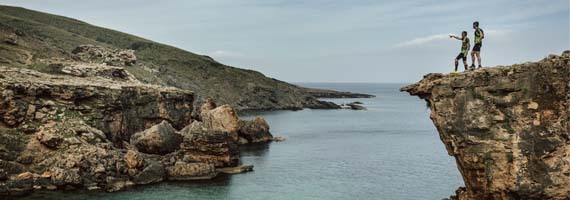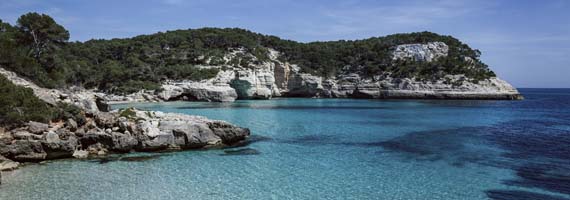
Camí de Cavalls 360º will let you discover the natural, historical and cultural wealth of one of the last paradises of the Mediterranean.
A SMALL ISLAND IN THE MIDDLE OF THE MEDITERRANEAN
Menorca inhabitants usually use the affectionate name “sa Roqueta” (the little Rock) to refer to Menorca. When seen on a map it can simply look like a little island in the middle of the Mediterranean, but this perception changes when you look at it closer: its little territory hides an infinite number of surprises, contrasts and spots. Menorca’s area covers about 700 km2, and at the furthest points, the island only covers 50 km from east to west, and a little more than 20 from north to south. The highest hill, called El Toro, is only 358 meters above sea level.
However, in an island this little we can find examples of almost every existing ecosystem in the Mediterranean, an admirable diversity of flora and fauna and a wide variety of endangered species or species with substantial ecological value. As an example, 7% of plants in Menorca are endemic, which means they are unique species in the world. In addition, the length of the coastline of the island has a considerable length: more than 200 kilometres of coast mainly virgin, moulded along the centuries and millennia by the sea and the wind.
BIOSPHERE RESERVE

The relation established between man and nature has been a constant feature in the history of an island with such a small territory, civilized but well preserved at the same time.
The goal of the protection of the territory is actually to preserve the harmony between the environment and the socioeconomic development, and the historical, artistic and cultural heritage of Menorca.
As a Biosphere Reserve, Menorca is a model of sustainable development. Still, the balance between socioeconomic development and respect towards nature is weak and requires constant efforts and surveillance.
CONTRAST OF LANDSCAPES
The enormous diversity of habitats and landscapes of Menorca is formed by a complex geological composition. In this sense, we can divide the island into two parts:

The NORTH is more diverse, consists of a mixture of ancient materials. The northern coast is very rugged and steep, and the landscape consists of hills and valleys, streams and wetlands. The materials which is formed by cause a predominance of dark colors. The northern beaches are varied, with sands of different colors and thickness, sometimes picturesque pebble beaches or beaches with large rounded stones.

The SOUTH consists of limestone and sandstone. It is lighter in color, and is more flat and homogeneous than the north. However, the southern half of the island is crisscrossed by numerous deep ravines that shape its relief. Unlike the north, the south coast is in general very straight and has plenty of fine, white sandy beaches, which are surrounded by pines, like Cala Mitjana (in the picture).
THE CONTRAST OF SEASONS

Visitors who only know Menorca as the dry, dusty ocher summer island are surprised when they see the lush greenery that covers Menorca the rest of the year. The island shows its beauty especially during autumn, winter and especially in spring spring, when the colors and odors of the flowers explode over the mantle of green grass.
The climate is typically Mediterranean: temperate, with hot, dry summers and rainy winters with mild temperatures. The climate oscillation results in a huge contrast between the different seasons and big transformations in the landscape. Every season offers a new face of the island, all of them with their own distinct personality.
AN OPEN-AIR MUSEUM

However, Menorca is not only rich in remains of the Bronze Age. We can also find important sites, monuments and ethnological material from all eras.
The Camí de Cavalls itself is an important part of the historical heritage of Menorca, and since it is a living heritage, perhaps it is more alive today than ever before.